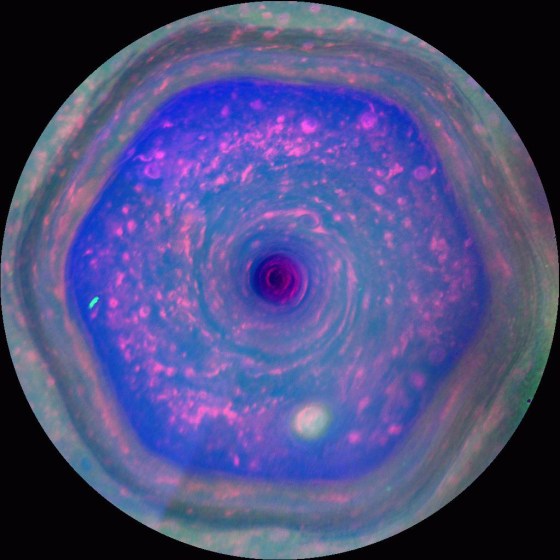NASA's Cassini orbiter has taken many pictures of Saturn's weird hexagonal storm system — but never like this. Newly released views show the Great Hexagon as a full-frontal cloud system, with Cassini's camera looking directly into the polar hurricane.
Spanning a distance of 20,000 miles (32,000 kilometers) across the planet's north pole, the hexagon is a wavy jet stream with a massive hurricane at the center. Winds whip around the eye of the storm at up to 330 mph (530 kilometers per hour).
"The hexagon is just a current of air, and weather features out there that share similarities to this are notoriously turbulent and unstable," Andrew Ingersoll, a Cassini imaging team member at the California Institute of Technology, said in a NASA news release. "A hurricane on Earth typically lasts a week, but this has been here for decades — and who knows, maybe centuries."
Cassini got its best view of the weather pattern when Saturn's changing seasons made it possible for the sun to illuminate the storm's interior in late 2012. The images were captured in multiple wavelengths, from ultraviolet to infrared, over the course of 10 hours last Dec. 10. Then they were color-coded and assembled into a killer animation.
Scientists studied the composition of the clouds inside and outside the hexagon. "Inside the hexagon, there are fewer large haze particles and a concentration of small haze particles, while outside the hexagon, the opposite is true," said Kunio Sayanagi, a Cassini imaging team associate at Hampton University. "The hexagonal jet stream is acting like a barrier, which results in something like Earth's Antarctic ozone hole."
On Earth, the ozone hole forms in a region that's enclosed by a polar jet stream. Chemical processes break down the ozone molecules within the region, but the jet stream blocks the resupply of ozone from outside the region. Seasonal changes affect the permeability of the barrier, and the same may hold true for Saturn.
"As we approach Saturn's summer solstice in 2017, lighting conditions over its north pole will improve, and we are excited to track the changes that occur both inside and outside the hexagon boundary," said Scott Edgington, Cassini deputy project scientist at NASA's Jet Propulsion Laboratory. Those observations will come just as Cassini approaches the scheduled end of its mission in September 2017.
Scientists discussed the new pictures, as well as the bigger picture for the Cassini mission, during an hourlong Google+ Hangout on Wednesday.
More pictures of the Great Hexagon:
- Bizarre hexagon spotted in Saturn's clouds
- Saturn's hexagon shows its true colors
- Who knew a Saturnian hurricane could be so lovely?
Alan Boyle is NBCNews.com's science editor. Connect with the Cosmic Log community by "liking" the NBC News Science Facebook page, following @b0yle on Twitter and adding +Alan Boyle to your Google+ circles. To keep up with NBCNews.com's stories about science and space, sign up for the Tech & Science newsletter, delivered to your email in-box every weekday. You can also check out "The Case for Pluto," my book about the controversial dwarf planet and the search for new worlds.
